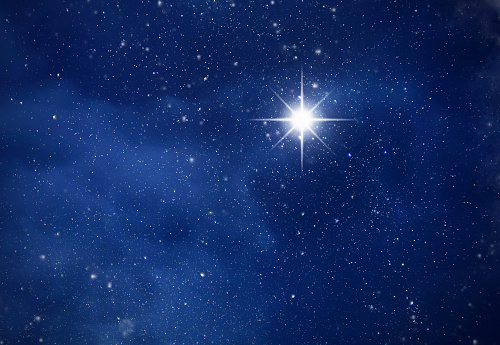Solar System: The Solar System is the gravitationally bound system of the Sun and the objects that orbit it, either directly or indirectly.
Stars
- Heat, light, ultraviolet rays, x-rays, and other kinds of radiation are produced by cosmic energy engines.
- A superheated condition of matter made of mostly of gas and plasma and containing subatomic particles.
- Luminosit: Brightness is a measure of how much energy they emit.
- The most basic component of stars: Hydrogen
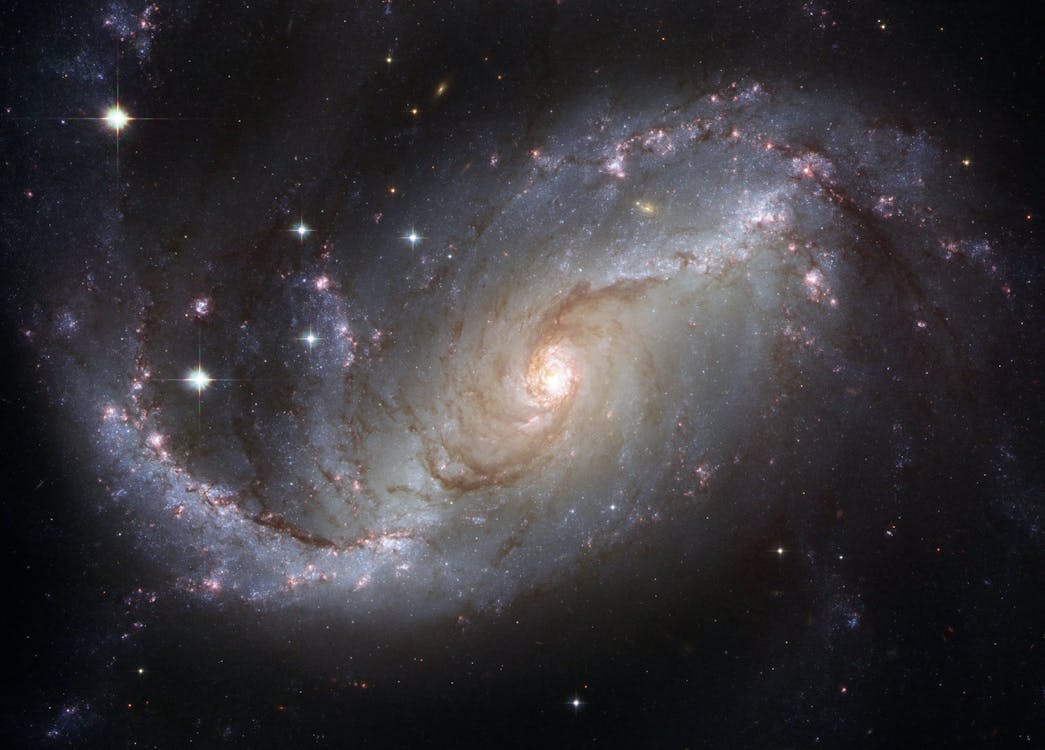
Moon
- The Earth’s only natural satellite
- was formed 4.6 billion years ago around some 30–50 million years after the formation of the solar system
- It is in synchronous rotation with Earth meaning the same side is always facing the Earth
- The rise and fall of the tides on Earth are caused by the Moon: There are two bulges in the Earth due to the gravitational pull that the Moon exerts; one on the side facing the Moon, and the other on the opposite side that faces away from the Moon, The bulges move around the oceans as the Earth rotates, causing high and low tides around the globe.
- A person would weigh much less on the Moon: The Moon has much weaker gravity than Earth, due to its smaller mass, so you would weigh about one-sixth of your weight on Earth.
- The Moon has quakes: These are caused by the gravitational pull of the Earth. Lunar astronauts used
seismographs on their visits to the Moon and found that small moonquakes occurred several kilometers beneath the surface, causing ruptures and cracks. Scientists think the Moon has a molten core, just like Earth.
Constellation
- A group of stars forming a recognizable pattern that is traditionally named after its apparent form or identified with a mythological figure
- Pole Star/North Star: Indicates the north direction (Locate the position of the Pole Star with the help of the Saptarishi)
Planets
Planets do not have their own heat and light and are lit by the light of the stars. A planet is a celestial body that:
- is in orbit around the Sun
- has sufficient mass for its self-gravity to overcome rigid body forces so that it assumes a hydrostatic equilibrium (nearly round) shape, and has cleared the neighborhood around its orbit.
Planets: Mercury, Venus, Earth, Mars, Jupiter, Saturn, Uranus, Neptune
- Pluto now falls into the dwarf planet category on account of its size and the fact that it resides within a zone of other similarly sized objects known as the transneptunian region.
- Planets with rings: Jupiter, Saturn, and Uranus have rings around them – belts of small debris
- Smallest planet: Mercury
- Largest planet: Jupiter
- Inner planets: Mercury, Venus, Earth, and Mars
- Outer planets: Jupiter, Saturn, Uranus and Neptune
- Planet Orbit: An orbit is a path an object takes in space as it revolves around another object. While a planet travels in one direction, it is also affected by the Sun’s gravity causing it to take a curved route that eventually brings it back to its starting point. This complete revolution equates to a single orbit.
Milky Way Galaxy
- Our solar system is a part of this galaxy
- Ancient India: Was imagined to be a river of light flowing in the sky and thus, named Akash Ganga.
Sun
- The center of the solar system and is made up of extremely hot gases; is the ultimate source of heat and light for the solar system
- Provides the pulling force that binds the solar system
- Contains more than 99.8% of the total mass of the Solar System (Jupiter contains most of the rest)
- The Sun is, at present, about 70% hydrogen and 28% helium by mass everything else (“metals”) amounts to
less than 2%. This changes slowly over time as the Sun converts hydrogen to helium in its core. - Light travels at the speed of about 300,000 km per second—the light of the sun takes about eight minutes to reach the earth.
Earth
- The third nearest planet to the Sun
- Fifth largest planet
- Geoid shaped: It is slightly flattened at the poles and that is why its shape is described as a Geoid (an earth-like shape)
- Blue Planet: its two-thirds surface is covered by water.
Satellite
- Natural Satellite: A celestial body that moves around the planets in the same way as the planets move around the sun.
- Human-made Satellite: An artificial body designed by scientists to gather information about the universe or for communication. It is carried by rocket and placed in the orbit around the earth.
Asteroids
- Numerous tiny bodies moving around the sun
- Found between the orbits of Mars and Jupiter
- Largest asteroid: Ceres
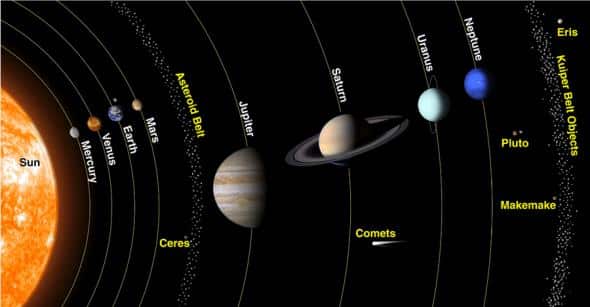
Meteors and Meteorites
While traveling through space, asteroids sometimes smash with each other & break up into minor remains. Comets shack dust as they wander the solar system. These ‘break ups’ result in frequent small particles & fragments, known as meteoroids, which orbit the sun.
Most meteoroids are rocky and small. When one draws near Earth, it burns up as it goes through the atmosphere of Earth. Thus a meteor is formed.
Fireballs are bigger meteoroids, approximately ranging in dimension anywhere from a basketball to a Volkswagen. They also make very imposing sky exhibits as they smash into fragments & burn up in their way through Earth’s atmosphere. Some meteoroids endure passage through the atmosphere of Earth & hit the ground. These are known as meteorites.
| Asteroid | Meteoroid |
| Asteroids are minor planets. | Meteorites are falling stars. |
| The orbital shape is elliptical and orbits the Sun | The orbital shape is elliptical and orbits the Sun but, get pulled into larger bodies. |
| Believed to be a leftover from the planet | Believed to be a smaller disintegrated element of comet or asteroid. |
| Do not have an atmosphere | Do not produce an atmosphere, but burn up when falling into a planet. |
| 1 to more than 100 kilometers in diameter | Typically, less than 10 meters. |
| Meteor | Meteorite |
| Meteors are still up in the sky. | Meteorites are on the earth. |
| Meteoroids break down in the earth’s atmosphere which results in the flash of light known meteors. | Meteorites are the broken meteoroids that land on the earth. |
Comets
Comets or ‘dirty snowballs’ are mostly made of dust, rocks, and ice and can range in their width from a few miles to tens of miles wide.
- When they orbit closer to the sun, like C/2020 F3, they heat up and release debris of dust and gases.
- The solid portions of comets consisting mostly of water, ice, and embedded dust particles are inactive when far away from the sun.
- When near the sun, the icy cometary surfaces vaporize and throw off large quantities of gas and dust thus forming the enormous atmosphere and tails.
- The released gases form a glowing head that can often be larger than a planet and the debris forms a tail that can stretch out to millions of miles.
- Each time a comet passes the sun, it loses some of its material and it will eventually disappear completely as a result.
- Comets may be occasionally pushed into orbits closer to the Sun and the Earth’s neighborhood due to forces of gravity.
- According to NASA, while there are millions of comets orbiting the sun, there are more than 3,650 known comets as of now.
- The predictable comets are the short-period comets that take less than 200 years to orbit around the sun.
- These can be found in the Kuiper belt, where many comets orbit the sun in the realm of Pluto.
- One of the most famous short-period comets is called Halley’s Comet that reappears every 76 years. Halley’s will be sighted next in 2062.
- The less-predictable comets can be found in the Oort cloud that is about 100,000 AU (Astronomical Unit which is the distance between the Earth and the Sun and is roughly 150 million km) from the sun or 100,000 times the distance between the Earth and the sun.
- Comets in this cloud can take as long as 30 million years to complete one rotation around the sun.
Visibility:
- Comets do not have the light of their own and the visibility depends on their gas and dust outbursts.
- Humans see the reflection of the sun’s light off the comet as well as the energy released by the gas molecules after it is absorbed from the sun.
- To be visible, a comet must make a particularly close approach to the sun to produce enormous quantities of gas and dust or it should make a relatively close approach to the Earth so that it is easily viewed.
Exoplanet
Exoplanets are the planets that orbit around other stars located outside our solar system. Exoplanets are also called extrasolar planets. All the stars have at least 1 planet revolving around them. Most of the exoplanets discovered so far are located in the Milky way galaxy.
They are also sometimes called “extrasolar planets“, “extra-” implying that they are outside of our solar system.
The Goldilocks Zone refers to the habitable zone around a star where the temperature is just right – not too hot and not too cold – for liquid water to exist on a planet.
- Our Earth is in the Sun’s Goldilocks zone. If Earth were where the dwarf planet Pluto is, all its water would freeze; on the other hand, if Earth were where Mercury is, all its water would boil off.
- Life on Earth started in water, and water is a necessary ingredient for life as we know it.
- So, when scientists search for the possibility of alien life, any rocky exoplanet in the habitable zone of its star is an exciting find.
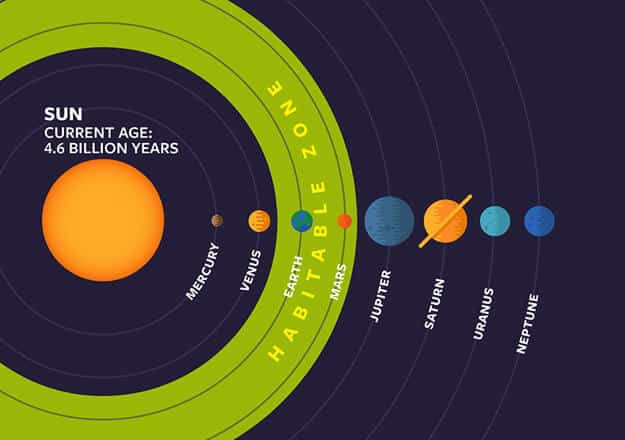
The TRAPPIST-1 planetary system sets a new record for the greatest number of habitable-zone planets found around a single star outside our solar system.
Sunspots
Sunspots (some as large as 50,000 km in diameter) are areas that appear dark on the surface of the Sun (photosphere). They appear dark because they are cooler than other parts of the Sun’s surface.
- However, the temperature of a sunspot is still very hot —around 6,500 degrees Fahrenheit.
- Photosphere is a visible surface of the Sun, from which is emitted most of the Sun’s light that reaches Earth directly.
They are relatively cool because they form at areas where magnetic fields are particularly strong. These magnetic fields are so strong that they keep some of the heat within the Sun from reaching the surface.
- Magnetic field in such areas is about 2,500 times stronger than Earth’s.
They typically consist of a dark region called the ‘umbra’, which is surrounded by a lighter region called the ‘penumbra’.
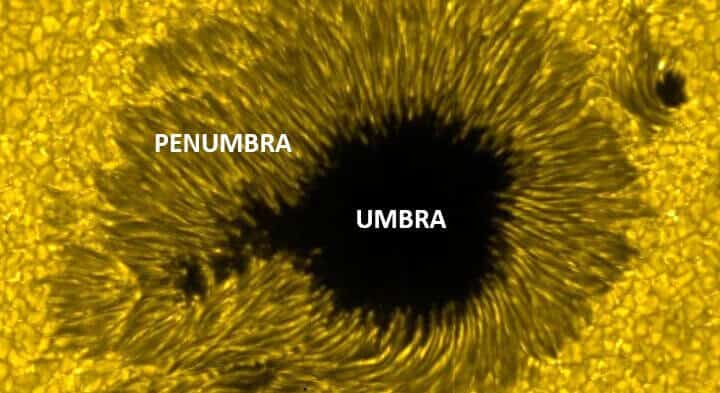
In every solar cycle, the number of Sunspots increases and decreases. The current solar cycle, which began in 2008, is in its ‘solar minimum’ phase, when the number of Sunspots and solar flares is at a routine low.
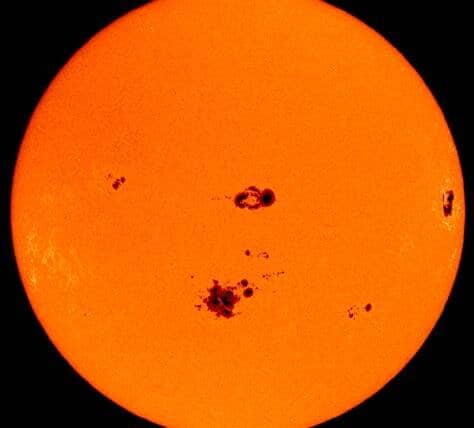
Solar Flares
- The magnetic field lines near sunspots often tangle, cross, and reorganize. This can cause a sudden explosion of energy called a solar flare.
- Solar flares release a lot of radiation into space. Solar flares, when powerful enough, can disrupt satellite and radio transmission on the Earth, and more severe ones can cause ‘geomagnetic storms’ that can damage transformers in power grids.
- A geomagnetic storm is a major disturbance of Earth’s magnetosphere that occurs when there is a very efficient exchange of energy from the solar wind into the space surrounding Earth.
- The magnetosphere is a region around the Earth dominated by the Earth’s magnetic field.
- It protects the Earth from solar and cosmic radiation as well as erosion of the atmosphere by the solar wind – the constant flow of charged particles streaming off the Sun.
- A geomagnetic storm is a major disturbance of Earth’s magnetosphere that occurs when there is a very efficient exchange of energy from the solar wind into the space surrounding Earth.
- Solar flares are sometimes accompanied by a Coronal Mass Ejection (CME).
- CMEs are huge bubbles of radiation and particles from the Sun’s Corona (outermost region of the Sun’s atmosphere). They explode into space at very high speed when the Sun’s magnetic field lines suddenly reorganize.
- They can trigger intense light in the sky on Earth, called auroras.
- Some of the energy and small particles travel down the magnetic field lines at the north and south poles into Earth’s atmosphere.
- There, the particles interact with gases in the atmosphere resulting in beautiful displays of light in the sky. Oxygen gives off the green and red light. Nitrogen glows blue and purple.
- The aurora in Earth’s northern atmosphere is called an aurora borealis or northern lights. Its southern counterpart is called an aurora australis or the southern lights.

Solar Cycle
- The Sun is a massive, electrically charged ball of heated gas. When this charged gas travels, it creates a strong magnetic field. The magnetic field of the Sun passes through a cycle known as the solar cycle.
- The Sun’s magnetic field totally turns every 11 years or so. The north and south poles of the Sun will transfer locations as a result of this. After then, it takes another 11 years for the Sun’s north and south poles to revert.
- The solar cycle has an impact on activity on the Sun’s surface, such as sunspots, which are created by the magnetic fields of the Sun. The amount of activity on the Sun’s surface changes as the magnetic fields fluctuate.
- Counting the number of sunspots is one approach to follow the solar cycle. A solar minimum, or when the Sun has the fewest sunspots, occurs at the start of a solar cycle. Solar activity—and the number of sunspots—increases with time.
- The solar maximum, or when the Sun has the most sunspots, occurs in the middle of the solar cycle. As the cycle comes to a conclusion, the sun returns to its lowest point, the solar minimum, and a new cycle starts.
References: NCERT Geography, Certificate Physical And Human Geography: G C Leong, https://lotusarise.com/
